Reducing Prompt Dependence in AAC Learners: 5 Things to Try
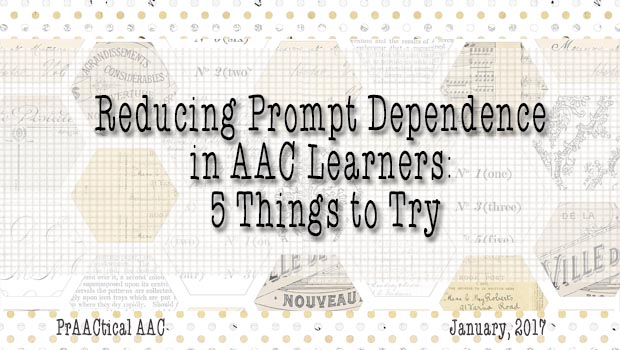
“He knows what to do. He just doesn’t do it.”
“He’s prompt-dependent. How can I get him to use AAC on his own?”
“I love his strong-willed nature, but it works against him sometimes. He doesn’t initiate.”
If any of these remarks sound familiar, it may be time to think about alternative approaches to build independent communication. Here are a few things to try with AAC users who’ve learned to wait for support before communicating.
- Exaggerate the pause time: Many of our AAC learners need at least 5 seconds of pause time after a communication opportunity presents itself. This helps them process the experience, organize their thoughts, decide on a response, and then begin to execute that response. Sometimes, though, we work with people who’ve learned that if they just wait, the communication partner will start to help (whether or not they need it). We can sometimes nudge the learner toward more independent communication by exaggerating the pause. That means using overt body language – a curious, expectant, posture and facial expression – and extending the pause. Nothing more happens until the learner responds. No repeating. No rephrasing. No fiddling with materials. No physical support. This creates a space that makes it more obvious to the learner, “It’s your turn to do something; Nothing fun will happen until you respond.” Harness the power of the perfect pause.
- Use visual supports instead of verbal or physical prompts: Both visual and auditory prompts (such as spoken cues) can help AAC learners know what to do/say next. It can be more difficult, though, to reduce reliance on our spoken prompts. Visual supports can be a better option for many individuals who are developing their communication skills with AAC. Consider substituting a visual cue for the auditory (verbal) cues to move the learner to increased independence.
- Fade gradually: We can also help learners become more independent by paying closer attention to the prompts we provide, and systematically reducing the amount of support we give. Elliott, for example, learned to create 2-symbol utterances with models, instructions, and a visual support (basically, a template with colored boxes for two symbols). Later, we faded the direct model (although aided language input continued for other things) and reduced the verbiage in the instructions. Eventually, he no longer needed those, but continued to glance at the visual support as a reminder to put two words together when using his communication board. We made that visual smaller and less distinct by copying on the photocopy machine and lightening the contrast to give us a faded facsimile of the original visual support. Over time, we faded it more and more until it was no longer visible. Slowly, Elliott took more responsibility for responding without the kinds of supports he started out with. It takes a little thought, brainstorming, and planning, but fading prompts systematically is a time-tested strategy that works in many situations.
- Use video modeling: Consider making video recording of the desired behavior and providing that to the client so that they can watch others demonstrate the target AAC skill. Even better: Record your client and edit out the prompts so that they can seem themselves doing it without any prompts or supports (i.e., video self-modeling). We’ve been pleasantly surprised by the impact this research-based strategy has had on our learners with significant cognitive challenges. If you haven’t yet used this powerful strategy, consider giving it a try. You can see it in action here.
- Involve the learner in tracking independent behaviors: In some situations, we can mobilize the power of competition by making the data collection explicit. Create a culture where noticing the target behavior and calling it out is part of the normal routine. In Jenna’s case, we have a vocabulary board with all her new words. Whenever anyone says one of those words, we make a mark next to that word. We even got a little fancy and used different colors for each of us. Jenna got really excited to make a mark whenever she heard us use the word and when she herself used it. Paying attention to how often we each used these words inspired her to find ways to integrate them into her sentences. For Thomas, who was learning to use a communication board rich in core vocabulary, we made a separate version of the board for data tracking. Each time someone used one of the target words on the boards, we gave it a star sticker. Everyone got inspired to try to beat the previous day’s score and we even had a leaderboard for awhile. When we track things in explicit ways, it tends to influence performance.
Do you have strategies that have helped AAC learners become more independent with their language and AAC skills? We’d love to hear about them.
Filed under: Featured Posts, PrAACtical Thinking
Tagged With: implementation ideas, prompting, the fives
This post was written by Carole Zangari

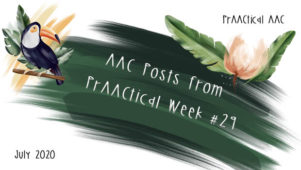
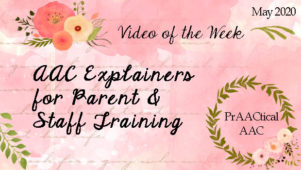
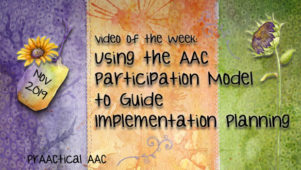
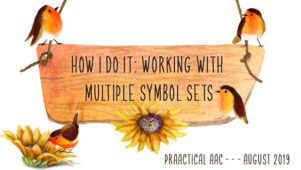
3 Comments
My daughter loves music so we would type together a line from her favourite song. We then put the music on & when the song got to the phrase we’d typed she would speak that in time to the music. At first she missed the beat but eventually she came in spot on with the song. We did this for multiple songs which Lucy loved but it quickened up her responce time in a way that was so much fun. Now she types the lyrics in herself & sings away. She’s a very competent aac user & now needs no prompting in fact she’s so fast at come backs we’re left Catching up with her.
What if the child you are working with is much older and heavily reliant on visual prompts? My kid wont answer unless there is something to look at. Even with a long pause, and even with practice. We have tried fading the visual prompt away by taking some of the images in the picture out slowly each time until there is nothing. But once there is nothing, there is no response. Even with waiting, my kid will just pick any answer. What would you suggest to lower the visual prompt dependency and help switch over to understanding receptive language?